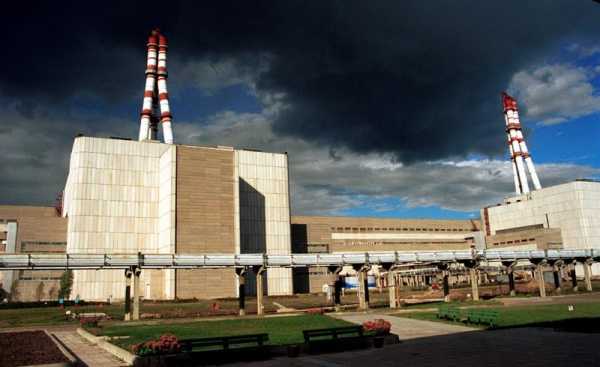
Ignalina nuclear power station in Lithuania (Photo: Wikipedia)
Last week, the International Atomic Energy Agency (IAEA) raised grave concerns after Ukraine and Russia had blamed each other for renewed shelling of Europe’s largest nuclear power plant in Zaporizhzya.
IAEA director Rafael Grossi warned of “the very real risk of a nuclear disaster that could threaten public health and the environment in Ukraine and beyond”. The plant, in Russian-controlled territory, has repeatedly been a focus in the war, as well as the damaged nuclear power plant in Chernobyl.
The war in Ukraine marks the first time we have seen an armed conflict take place near nuclear power plants.
Reactors are not designed to withstand military fire. Their safe operation also depends on the uninterrupted supply of electrical power and the availability of highly specialised personnel. Both are at risk in a war.
An interactive map by Greenpeace shows how close Russian attacks have already come to Ukrainian nuclear power plants in the months of war.
The recently adopted Nato strategy rates Russia as “the greatest and most immediate threat to the security of allies and to peace and stability in the Euro-Atlantic area.”
Nato is responding to the new situation with deterrence through a massive rearmament effort. As in the days of the Cold War, the worst is expected — and, in this case, the worst-case scenario would be a Russian attack on a Nato member.
How concrete fear of war has become can be seen in Finland and Sweden, which after a long period of neutrality are now also seeking a spot under the Nato umbrella.
Concerns about the safety of their own nuclear power plants may have played a role.
Finland started test operations for Olkiluoto 3, the world’s largest nuclear power plant, in March.
Nuclear power is expected to not only make it possible for many European countries to phase out coal-fired power generation early, but also to free them from dependence on Russian gas and secure their energy supplies now that Russia has invaded.
In the UK, prime minister Boris Johnson’s ambitious energy strategy envisages the construction of eight new nuclear reactors in the UK by 2030. This is intended to follow in the footsteps of France, which is known for its energy independence thanks to its 56 nuclear reactors.
The Bertelsmann Stiftung’s, a German foundation’s Sustainable Governance Indicators (SGI) country report on France (2021) blames the French nuclear miracle primarily on powerful lobby groups: “France lags far behind most European countries in the expansion of renewable energy, due to effective lobbying by pro-nuclear elites allied with one of the largest trade unions (CGT).”
Also in the new SGI country report, to be published in the fall, the authors criticise the complex licensing procedures for renewables and opposition from interest groups that prevent energy types other than nuclear from moving forward.
At the same time, France’s nuclear energy is not faring so well at the moment.
Some 29 of the 56 reactors are currently shut down for regulatory maintenance or due to corrosion damage. On average, they have been in operation for more than 36 years and are therefore highly susceptible to failure due to their age.
In its business dealings as well as in its global lobbying for nuclear power as a green alternative, the French nuclear industry has also close cooperated with the Russian state corporation Rosatom.
As recently as December 2021, another long-term strategic cooperation was agreed between Framatom, a subsidiary of the French utility and nuclear power plant operator Electricité de France, and Rosatom.
Russian nuclear dependence
Meanwhile, the extent of Russian influence on Western nuclear energy markets is shown in a study by the Columbia Center on Global Energy Policy.
According to the study, there are Russian nuclear reactors in 18 EU countries: two in Bulgaria, six in the Czech Republic, two in Finland, four in Hungary and four in Slovakia.
Five more Russian-designed reactors were under construction in 2021: one in Finland, two in Hungary and two in Slovakia, although Finland has already recently announced the end of reactor construction with Rosatom at Hanhikivi.
The Czech Republic is also slow by European standards in expanding renewable energy.
When the European Green Deal was negotiated in Brussels in the fall of 2021, the country joined France in calling for nuclear to be classified as clean energy to spur investment in new reactor construction.
But the SGI’s Czech Republic 2021 country report had already warned: “Caution is needed when selecting the international partners needed to build a new nuclear power plant. Costs, national safety, and international alliances must be carefully balanced in planning and calculations.”
Because Russia also plays such a weighty role globally in nuclear fuel production services, even countries that don’t have Russian-designed reactors are hardly independent.
Realigning supply chains in terms of components and services for Russian-designed reactors is almost impossible because of their significant dependence on the manufacturer of the reactor type.
But breaking away from the Russia in the supply chain for nuclear fuel is proving difficult, to say the least.
This may also explain why the Russian state-owned corporation Rosatom has not yet been sanctioned by the EU and why nuclear companies such as Framatom have not yet discontinued their business relations with Russia.
For most European countries, improving the resilience of the energy supply and achieving greater energy self-sufficiency can hardly be achieved by expanding nuclear energy or extending the operating lives of reactors.
Economic ties with Rosatom and dependencies of the European nuclear industry on Russian nuclear technology and nuclear fuel production are too tight.
Nato’s reassessment of the military threat to Europe also requires a rethinking of the risks of nuclear energy.
Source: euobserver.com



